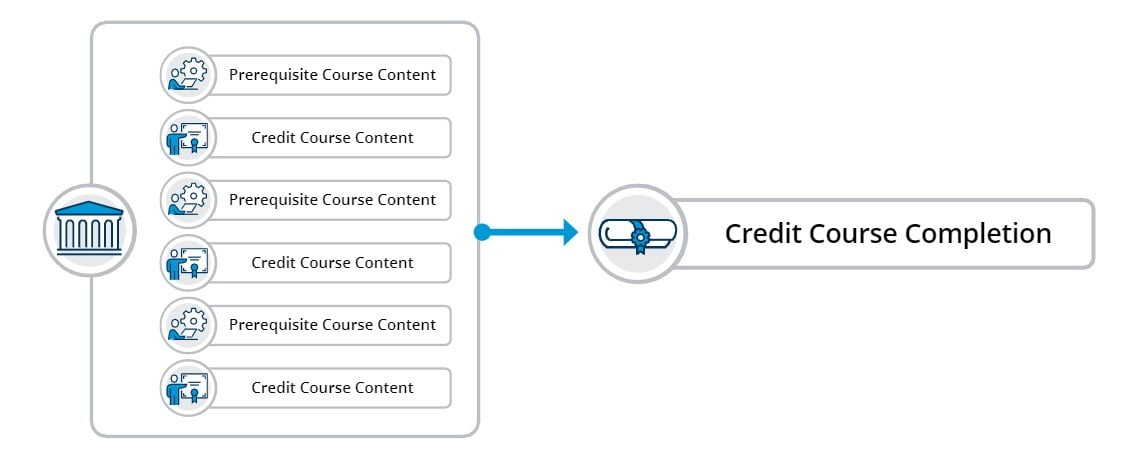Across two- and four-year institutions, remedial courses have long been a staple in helping underprepared students ramp up. However, consistently disappointing results have prompted higher education leaders to explore alternatives. Considering only 35% of four-year students graduate within six years, higher education policymakers, organizations and institutions are adopting corequisite remediation in an attempt to boost retention and graduation rates among new students.
Read on as we explore the basics of corequisites—highlighting what they are, how they’re organized and which common models to consider for your pedagogy and students’ needs.
What Is a Corequisite Course?
Corequisites allow students to combine a remedial course with a credit-bearing course—and complete both in a single semester. Unlike standard prerequisites, corequisites eliminate the need for students to take multiple unaccredited remedial classes before starting standard classes. As a result, students assessed as unprepared for college-level work can finish their degrees in the same amount of time as traditional students—saving them time and money while boosting retention rates.
One report analyzing Ivy Tech Community College campuses in Indiana saw a 75% pass rate for corequisite students compared to a 37% pass rate for students using prerequisite methods. Moreover, the Community College Research Center at Columbia University found corequisites to be substantially more cost-effective than prerequisites—cutting costs by 11% for each successful student.
Due to the promising results, institutions are replacing their standard prerequisite courses with corequisites—a trend highlighted by increasing state, departmental and institutional mandates. To that end, what do instructors need to know to make the most of their institution’s implementation policies?
What Instructors Should Know
Whether your institution is implementing a new model or you’re entering a new institution leveraging coreqs, understanding the basics behind them can make it easier to effectively engage your students and guide them toward successful completion of your course.
Classroom Organization
Keeping in mind that corequisite courses combine remedial content with credit-bearing classes, how you structure your class can have a profound impact on classroom dynamics, prep time, engagement and student assessment. At a high-level, there are two class organizations you should consider before choosing a corequisite model for your class; comingled and cohort.
Comingled Organization: This organizational approach blends college-ready and underprepared students together, making it unclear to the class which students are getting remedial support. This is a common approach to help foster a feeling of inclusion and belonging in the college experience.
Cohort Organization: Students assessed as unprepared are organized into their own class or section with students in need of similar support. While these students are enrolled in the same credit-bearing class as every other student, the organization makes it easier for instructors to assess and support their unique learning needs. Students in a cohort class may meet five days instead of four in a traditional class—using one day to focus on remedial support.
Common Implementation Models to Consider
Corequisite implementations can vary widely depending on the needs of the institution, instructor and class. However, there are three common models that are typically used to set the framework for effective remedial instruction—and all are flexible to the needs of your unique pedagogy.
1. Separate Support Lab or Course Model
Students take one class that covers their credit-bearing and prerequisite course requirements, with an added lab paired with the credited course. Instructors can use the lab time to prepare students for upcoming foundational concepts, assess student progress and address foundational skills.
Separate support models allocate instructors to either prerequisite course or credit-bearing course instruction. This model makes course preparation easier while also enabling tailored instruction and assessment of progress.

2. Compressed or Stacked Model
In compressed models, prerequisite help and content are front-loaded at the start of the semester, giving students a “crash course” of key course concepts to bring them up to speed before completing credit-bearing course requirements. On average, students spend eight weeks taking remedial prep and eight weeks taking standard lessons—completing both in one class.
Compressed (stacked) models are especially useful for instructors who want to assess student readiness before delving into complex subject matter. This approach also provides students with the added convenience and affordability of taking only one class.

3. Integrated Model with Just-in-Time Support
Integrated models take a standard credit-bearing course and provide remedial students with prerequisite course content as they need it. Like the compressed model, there is no additional lab or support course for underprepared students with this approach. Instead, it relies on instructors to understand the needs of their remedial students and address them accordingly.
This model provides students with tailored help without asking them to spend additional time and money on a separate course. Using a cohort style organization is often recommended, as it significantly cuts down on course setup and materials.

Want to Learn Even More About Corequisite Models?
For more information on how to get started with corequisite courses, the pros and cons of each model, a checklist you can use to shape your classroom and more, check out our recent ebook, Getting Started with Corequisites.

